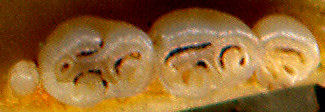Birch mice occupy forests, meadows, and arid grasslands from Europe into Central Asia. Jumping mice are mostly North American (Zapus, Napaeozapus), but one genus (Eozapus) occurs in China. Jerboas range geographically from the Sahara to the Gobi deserts. The first two of these groups generally have been considered to make up the family Zapodidae, and most of the literature you're apt to see will so list them.
In the Southwest, populations of jumping mice were considered to be Zapus princeps (Western Jumping Mouse) until 1981, when Hafner et al. looked critically at the New Mexican jumping mice. Before that time, two subspecies of the Western Jumping Mouse were considered to be present: Z. p. princeps in far northern New Mexico and Z. p. luteus to the south in montane and riverine habitats. Hafner et al. showed that the taxon known as Z. p. luteus is, in fact, a peripheral isolate of Zapus hudsonius (Meadow Jumping Mouse), otherwise known only from as far south as northern Colorado in the Southwest. Occurrences of Z. h. luteus are in the Rio Grande Valley and some tributaries south to about Socorro; other populations are in the New Mexican Sacramento Mountains and in the White Mountains of Arizona.
 Jumping mice have the elongated hind feet and very long tail usually
associated with jumping locomotion. They generally are found in moist grassy and brushy areas. The molars are rather complex and will distinguish between Z. hudsonius and Z. princeps.
The very large infraorbital foramen in a mouse-sized skull allows easy identification to family.
Jumping mice have the elongated hind feet and very long tail usually
associated with jumping locomotion. They generally are found in moist grassy and brushy areas. The molars are rather complex and will distinguish between Z. hudsonius and Z. princeps.
The very large infraorbital foramen in a mouse-sized skull allows easy identification to family.
Fig. 1. Upper P4-M3 of Zapus hudsonius.
Although the arid-land dwelling jerboas (11 genera) are not found in the New World, they are worthy of mention because of the morphological convergence with the exclusively New World kangaroo rats (Dipodomys). Such convergence includes enlarged hind limbs and reduced fore limbs, huge feet, a long tail, greatly enlarged bullae (in some), and, to a degree, color patterns. Some specializations have gone further in jerboas than in kangaroo rats, however, including the even greater disparity between hind and fore limbs (the former are at least four times longer) and, in most genera, the fusion of metatarsals II, III, and IV into a cannon bone and loss or extreme reduction of other digits.
Last Update: 31 Jan 2008
Centennial Museum and Department of Biological Sciences, The University of Texas at El Paso